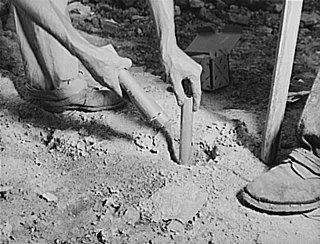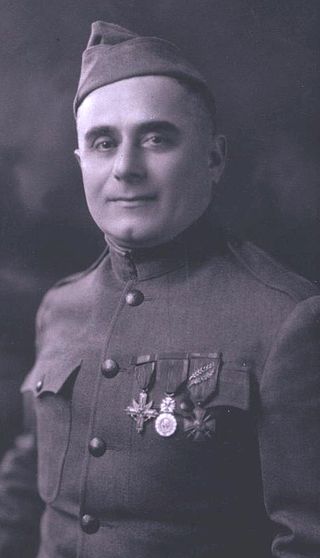
Dynamite is an explosive made of nitroglycerin, sorbents, and stabilizers. It was invented by the Swedish chemist and engineer Alfred Nobel in Geesthacht, Northern Germany, and was patented in 1867. It rapidly gained wide-scale use as a more robust alternative to the traditional black powder explosives. It allows the use of nitroglycerine's favorable explosive properties while greatly reducing its risk of accidental detonation.
Soldier of fortune or Soldier of Fortune may refer to:

Emilio Ivan Kosterlitzky was a Russian-born Mexican colonel during the Mexican Revolution. He had also served in the Mexican Apache Wars and Yaqui Wars. He is most noted for being the commander of the Mexican Rurales, or border police, during the late 19th century.

Samuel Dreben, sometimes misspelled "Drebben" or "Drebin", and known as "The Fighting Jew", was a highly decorated soldier in the US Army and a mercenary who fought in a variety of wars and revolutions.
The Hassan uprising was a rebellion among the Moro people of Jolo during the Moro Rebellion. It was led by a Muslim datu named Datu Hassan, the youngest son of the Great Raja Muda Ammang. Panglima Hassan had assembled followers in Jolo's Crater Lake region, preparing to attack Jolo. Leonard Wood led a force of 1,250 soldiers, including Robert L. Bullard's 28th Infantry, in an attack on "Hassan's Palace", the "strongest cotta in the Sulu Archipelago". The Moro's fled and the Americans burned the fort. Hassan surrendered but then escaped, which led Wood to destroy every hostile cotta he encountered, resulting in the death of Datu Andung on Mount Suliman. Although never capturing Hassan, Wood did end up killing 1,500 Moros, which included women and children.

The First Battle of Ciudad Juárez took place in April and May 1911 between federal forces loyal to President Porfirio Díaz and rebel forces of Francisco Madero, during the Mexican Revolution. Pascual Orozco and Pancho Villa commanded Madero's army, which besieged Ciudad Juárez, Chihuahua. After two days of fighting the city's garrison surrendered and Orozco and Villa took control of the town. The fall of Ciudad Juárez to Madero, combined with Emiliano Zapata's taking of Cuautla in Morelos, convinced Díaz that he could not hope to defeat the rebels. As a result, he agreed to the Treaty of Ciudad Juárez, resigned and went into exile in France, thus ending the initial stage of the Mexican Revolution.
Felix A. Sommerfeld was a German secret service agent in Mexico and the United States between 1908 and 1919. He was chief of the Mexican secret service under President Francisco I. Madero, worked as a diplomat and arms buyer for Venustiano Carranza and Francisco "Pancho" Villa, and ran the Mexican portion of Germany's war strategy in North America between 1914 and 1917.

Emil Lugwig "Lewis" Holmdahl was an American soldier of fortune, infantryman, machine gunner, spy, gun runner, and treasure hunter who fought under Frederick Funston and John J. Pershing in the Spanish–American War and subsequent Philippine–American War, under Lee Christmas in Central America, under Francisco Madero, Pancho Villa, and Venustiano Carranza in the Mexican Revolution, and under John J. Pershing again in World War I. In 1926, Holmdahl was accused of having stolen Francisco "Pancho" Villa's head.

Jorge Ulises Orozco was a Mexican diplomat during the Venustiano Carranza presidency. He was the Mexican consul in El Paso, Texas.

The Bombing of Naco was an international incident which occurred in the border town of Naco, Arizona, during the 1929 Escobar Rebellion. While rebel forces were battling Mexican 'Federales' for control of the neighboring town of Naco, Sonora, the Irish-American mercenary and pilot Patrick Murphy was hired to bombard the government forces with improvised explosives dropped from his biplane. During the ensuing fighting, Murphy mistakenly dropped bombs on the American side of the international border on three occasions, causing significant damage to both private and government-owned property, as well as slight injuries to several American spectators watching the battle from across the border. The bombing, although unintentional, is noted for being the first aerial bombardment of the continental United States by a foreign power in history.
The Raid on Mazatlán Railway was a raid launched by supporters of General Francisco I. Madero against the Mazatlán Railway held by supporters of Porfirio Díaz, under the command of the American soldier of fortune, Emil Lewis Holmdahl.
The Costa Oeste Campaign was a military campaign during the opening stages of the Mexican Revolution, in which the federal government of Mexican president Porfirio Díaz and the commander of the Rurales, Emilio Kosterlitzky, who faced off against supporters of the American soldier of fortune, Emil Lewis Holmdahl.
The Capture of Rosario was an action during the Mexican Revolution, where two rebel commanders, Martin Epsinosa and the American soldier of fortune, Emil Lewis Holmdahl captured the government stronghold of Rosario.
The Capture of Rosamorada was an action during the Mexican Revolution, where two rebel commanders, Martín Espinosa and the American soldier of fortune, Emil Lewis Holmdahl captured the government stronghold of Rosamorada.
The Fall of Tepic was an action during the Mexican Revolution, where two rebel commanders, Martín Espinosa and the American soldier of fortune, Emil Lewis Holmdahl captured the provincial capital of Tepic.
The Battle of Tepic was an engagement during the Mexican Revolution where two formers allies Emil Lewis Holmdahl and Martín Espinosa, turned enemies fought for control over the provincial capital of Tepic.
The Battle of Parque was a battle during the Mexican Revolution, where Emiliano Zapata and his supporters rebelling against president Francisco I. Madero, who had recently overthrown the previous president Porfirio Díaz. A group of Zapata's supporters attempted to ambush a train containing 27 Mexican Rurales under the command of the American Soldier of Fortune, Emil Lewis Holmdahl.
The Battle of Cuernavaca was a battle during the Mexican Revolution, where Emiliano Zapata and his supporters rebelling against president Francisco I. Madero, who had recently overthrown the previous president Porfirio Díaz. Zapata was patrolling around his stronghold in the hills of Cuernavaca, where he was ambushed by a government force of Rurales under the command of the American Soldier of Fortune, Emil Lewis Holmdahl.
The Battle of San Andrés, also known as the Charge at San Andrés, took place during the Mexican Revolution and was fought on August 26–27, 1913. Revolutionary leader General Pancho Villa attacked the town of San Andrés, and the battle concluded when the American soldier of fortune charged the federal positions and routed the enemy. A thousand government soldiers were killed, and 400 prisoners were executed by Villa's self styled executioner, Rodolfo Fierro.
The Battle of Zaragoza took place during the Mexican Revolution in late November 1913, a few days after the Battle of Tierra Blanca. Pancho Villa's trusted commander, the American soldier of fortune, E.L Holmdahl attacked the camp of a group of Huertist who were raiding rebel territory from the US. Holmdahl, despite being outnumbered, attacked and trapped the enemy, killing 172 while the remaining 28 were executed by his men against Holmdahl's orders.






